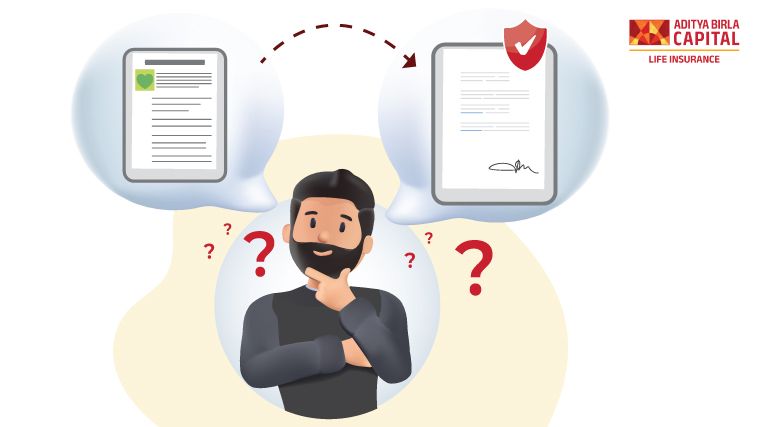When you start earning yourself, you start understanding the value of money and financial planning morsoever when you build a family of your own. Life is utterly unpredictable, and protecting your loved ones against all odds becomes your utmost priority. That is when you come across term insurance - a simple yet crucial product that will financially safeguard your family, in your absence. But how do you find the best term insurance policy?
Well, there is no one ‘best’ policy available in the market. If you want your term plan to be the ‘best’, make sure you buy the right cover, customize it according to your needs (select a plan that offers the customization options you require), and purchase it from the right insurer.
In this article, we will help you curate a term plan that will be tailored to your own unique needs that will be right for you. Let’s begin!
How To Choose The Best Term Insurance Plan In India?
Here’s a step-by-step guide to choosing a term insurance policy that is the ‘best’ for you -
Conduct Thorough Research –
When you want to buy something, say, an electronic device like a PC, you check out its features and specifications. But most importantly, you check its manufacturer, quality, etc, before you trust that product with your money.
In the same way, when you decide to purchase a term plan, you need to weigh the features, benefits, and costs. But what's even more important is to buy it from a reputable insurance company. This is crucial because term insurance is a long-term commitment.
Purchasing from a reliable insurer ensures a seamless experience for you during and after purchase, and for your family during a claim. If you face any issue during the policy purchase or the policy period, you can discuss it with them and they will do their best to resolve it. A good insurer will also ensure that the claim process runs smoothly without any hiccups.
You can find out if an insurer is credible or not by checking their claim settlement ratio (CSR).
Generally the higher the claim settlement ratio, the more reliable the insurance company. You can also check the reviews of previous customers to gain a better understanding of the insurer’s services.
Select Appropriate Cover Amount -
Next, you should decide how much cover to buy under the policy. You may rush into buying a larger cover, say a 1 Crore cover, thinking it would be appropriate for your family. Today, a 1 Crore cover might seem large, but it may not be sufficient enough to cover your family's future needs. It is, therefore, crucial to obtain the right level of coverage based on your family's needs. As a result, you can ensure that your family is financially secure and won't end up with insufficient funds in the future.
You can calculate the sum assured to cover your family's needs in two ways.
Calculate manually
Identify the gap between what you will leave behind and what your family actually needs - to determine the appropriate term cover. You can find the gap by calculating the difference between -
1. How much do you owe? - This includes your short and long-term expenses, long-term financial goals, loans, etc.
2. How much do you own? - This includes the funds you own, your
savings, investments, FDs, etc.
By finding out the difference between these two amounts, you will discover the financial gap that needs to be filled with term insurance.
Also, make sure to factor in 6-8% inflation, while calculating the cover amount to ensure your family is adequately covered in the future.
Moreover, if you have existing [life insurance](https://lifeinsurance.adityabirlacapital.com/), subtract that amount from your current coverage. Then, purchase the term insurance policy to cover the difference.
Use HLV Calculator
Our Human Life Value (HLV) calculator can also be used to calculate the cover amount. It will provide you with the right cover amount based on your answers to a few simple questions, within 2 minutes.
Choose The Right Type That Meets Your Needs –
Term insurance plans come in different variants and each of these types is unique, has its own set of features, and is tailored to meet your specific needs.
- If you want to buy term insurance only to cover your outstanding loans/liabilities, you can choose the decreasing term plan. Under this option, the sum assured decreases at a predetermined rate once every 5 years until it reaches a maximum limit of 50% of the base cover. If you pass away unexpectedly while the plan is in force, the insurer will pay the decreased sum assured to your family which can be used to settle the loan/liability.
- If you want to add your spouse to your policy, you can opt for a joint life plan. Under this, both you and your spouse will be covered under a single plan.
- Normally, term insurance doesn’t pay anything back if you outlive the policy term. If you’re not happy with such a proposition, you can consider buying a Term Return of Premium or TROP plan. This plan offers a maturity benefit in addition to a death benefit. So, if you pass away while the policy is active, your nominee will get the death benefit and if you survive, you will get a maturity benefit - all the premiums you paid (minus the taxes) will be returned to you.
Aside from these options, many others cater to your specific needs. You can choose the one that fits your needs the best.
Choose The Right Premium Payment Term –
You will need to make premium payments to keep the policy active. Generally, you are required to pay the premiums until the end of the policy period you choose. This is the regular pay option. For instance, if you choose a policy period of 30 years, you must pay premiums for 30 years.
However, if you think you may have fluctuating income in the future, you may wish to pay off your premiums early, so as not to be burdened with premium payments for a very long time. In this case, you can choose either of these options to pay your premiums -
- The single pay option lets you pay your entire premium in a single go.
- The limited pay option allows you to complete your premium payment obligations in fewer years. And, the insurance cover and its benefits will remain intact until the policy period ends.
Choose The Right Premium Payment Frequency –
You can also choose how frequently you want to pay your term insurance premiums along with the payment term.
In this case, you can choose either of these options to pay your premiums -
- If you can afford to pay large premium amounts every year, you can choose the annual premium payment option.
- Alternatively, if you find this option burdensome, you can opt for a half-yearly premium payment option, where you can pay your premiums every six months.
- If you are a salaried employee, you may find smaller premium instalments to be more convenient. In that case, you can choose a quarterly or monthly premium payment option.
Note: Regardless of the frequency of premium payments, make sure you have set up an auto- debit or standing instruction on your bank account. In this way, your premiums will be paid on time, and your policy will not lapse.
Opt For Increasing Cover - To Ensure Adequate Coverage –
Your expenses may increase as you age and take on more responsibilities, get married, have kids, etc. Hence, there may be a constant need to upgrade your cover to keep up with your growing family's needs. In this case, you can choose the increasing cover option, whereby the cover amount will increase gradually at specific intervals until it reaches a maximum limit. This option also helps you counter inflation.
Make Sure You Choose The Right Insurance Riders –
Term insurance provides basic life coverage. But, if you want to cover risks, such as - accidents, critical illness diagnosis, accidental disability, etc. - which can threaten the financial stability of your family, consider adding riders.
Insurance riders are add-on benefits that can be added to your policy at a certain extra yet reasonable cost. They make your policy more comprehensive. When choosing an insurer, always consider one that provides you with multiple rider options.
For example, say you add a waiver of premium on critical illness rider to your term plan. Now, if you are diagnosed with a serious illness that is listed in the policy document, this rider will waive all your future policy premiums. This means you can enjoy the cover for the rest of the policy term - without paying any future premiums. This is why you need to look for the best term plan with critical illness cover!
Here are some common types of riders available with a term insurance policy -
- Critical illness rider
- Accidental disability rider
- Accidental death benefit rider
- Hospital cash rider
- Surgical care rider
- Waiver of premium on critical illness rider
- Waiver of premium on accidental disability rider
Purchase Your Plan Under MWP Act
According to the law, the insurance claim amount that your family will receive will be used first to settle any unpaid loans and liabilities. Also, there may be family members who will barge in to get their hands on the claim amount based on succession laws. It can be extremely difficult to deal with these situations.
There is still a way out - if you are married and male. You can purchase your term plan under the Married Women's Property Act (MWP) by agreeing to an additional addendum. This will ensure that the term insurance claim amount directly reaches your wife before it goes to anyone else.
Decoding The Right Sum Assured Option For You-
Finding the perfect sum assured is a crucial part of creating a top-notch term insurance policy that suits your requirements. This amount determines the financial security your loved ones will get if you, unfortunately, pass away while the policy is active. It plays a vital role in guaranteeing that your family is well taken care of in your absence. Think of the sum assured as a financial shield for your family.
Here are some significant things to keep in mind while picking a sum assured:
-
Evaluate your requirements thoroughly when choosing term insurance. Determine the sum assured that will adequately replace your income and cover essential expenses, debts, and future aspirations such as education or marriage for your family
-
Take inflation into account to ensure that the sum assured maintains its actual value over time, safeguarding your family's changing financial needs.
-
Make sure the amount of coverage you choose extends to important future milestones, such as your children's education. This will give your family the financial support they need to pursue their dreams and aspirations.
If you have outstanding loans, a substantial sum assured can help settle them, alleviating your family's financial burden and protecting your assets. Choose the right sum assured for your term insurance carefully. It's important to make a responsible decision for your family's financial security. Consider future goals, like funding your children's education, to ensure your coverage is sufficient. With the right amount of coverage, you can have peace of mind knowing your loved ones are financially protected in unforeseen circumstances.
Choosing The Right Claim Payout Option-
You might have heard stories about lottery winners going bankrupt after gambling or investing poorly. The same holds true for large claim payouts. If you pass away unexpectedly during the policy tenure, your family will receive a claim payout as a lump sum. The large sum of money may seem overwhelming to them, and they may not know how to handle it.
To avoid your family losing the claim amount through bad investments, you can customise how they receive it.
-
If you believe your nominee is financially savvy and will be able to handle large amounts, you can choose the lump-sum payout option.
-
If you believe your nominee will be unable to handle a large amount of money and you want the claim amount to cover your family's everyday expenses, such as grocery bills and electricity bills, you can consider the monthly-income payout option.
-
If your nominee is not financially savvy and you have small debts to settle, you can choose the lump sum with a monthly income payout option. Here, a portion of the claim will be paid in a lump sum and the rest in monthly instalments for a specified period.
So, these are some of the factors that will ensure you buy a term insurance policy that is best suited for your and your family’s requirements.
Wrapping up!
While choosing a term plan, the first thing most people do is compare prices. Yes, price is important - but not as important as your family’s financial security. Your needs and requirements should first align with your policy’s features and benefits. That’s what ultimately makes it the ‘best’ for you.










